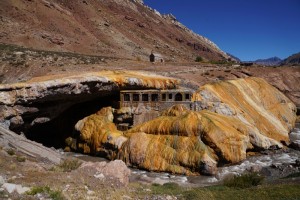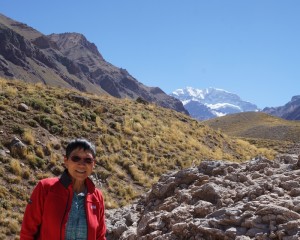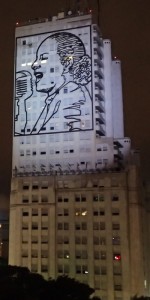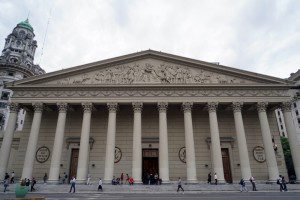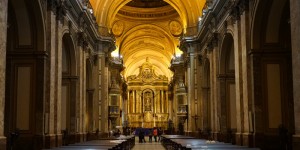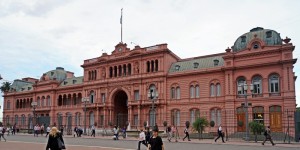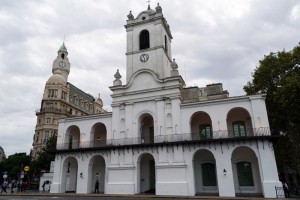Argentina- Mendoza & Buenos Aires & Montevideo, Uruguay: March 30 – April 3, 2017
March 30 Thursday: Mendoza – Wine-tasting Tour
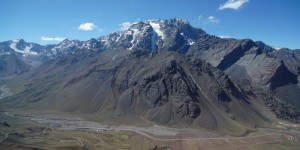 Mendoza (746m above sea level) located in the northern-central part of the province of Mendoza and 430km from La Rioja, was founded in 1561 and named after the governor of Chile Don García Hurtado de Mendoza. The legendary Route 7 running between Buenos Aires and Santiago, Chile, runs through the city.
Mendoza (746m above sea level) located in the northern-central part of the province of Mendoza and 430km from La Rioja, was founded in 1561 and named after the governor of Chile Don García Hurtado de Mendoza. The legendary Route 7 running between Buenos Aires and Santiago, Chile, runs through the city.
Mendoza, the provincial capital, is a centre for ecotourism. It is the gateway for climbers for Aconcagua (6962m), the highest mountain in Argentina and in Western and Southern Hemisphere. Nature and adventure seekers come here for its landscape, scenery, rafting and climbing. The regional around Greater Mendoza is the largest wine producing area in Latin America, The country’s highly rated Malbec wines originate from Mendoza’s high-altitude wine regions of Lujan de Cuyo and Uco Valley located in the foothills of the Andes mountains between 850m and 1525m elevation. Many tourists follow the wine route and take wine-tasting tours. 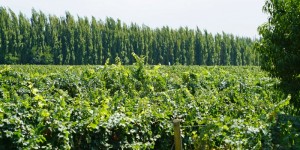
The main industries of the area are tourism, wine and olive oil production. Mendoza is a leafy and beautiful city thanks to a system of irrigation developed well before the arrival of the Spaniards. The centre systemically laid out, is centred around Independence Plaza with four smaller plazas. An unique feature in the city is the exposed stone ditches which run alongside many of the roads supplying water to the trees lining the streets. Just off the city centre is the expansive General San Martín Park.
By 6am, I was fully awake. It had been raining heavily and the sky was grey. As a result, there was no sunrise. As soon as I got off the bus, I purchased another overnight bus ticket departing for Buenos Aires at 8:30pm on April 1. I got a promotional ticket for ARS 931.
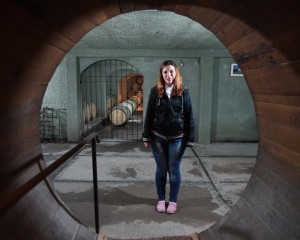 I had not yet reserved any accommodation but I had a couple of places in mind. I took a taxi to the city centre and picked Hotel Niventus (ARS 700 a night with breakfast). My original choice was Hotel Cevantes (ARS1000) which is a much nicer 3-star hotel: I should have treated myself better and stayed there. After an hour’s rest, I was ready to venture out. I found a tour operator and booked three excursions for ARS 2000 including a wine-tasting tour, a full day excursion to ‘Alto Monataña’ (High Mountain) and a half-day horse-riding and winery tour. Today I got ARS 17.4 for an euro and ARS 15.6 for a dollar. When I passed by McDonald, I decided to take a new BBQ set lunch for ARS 160 (not too cheap at all). The burger has two pieces of barbacued minced meat. I find both the meat and bun too sweet. Anyway, I do not like fast food!
I had not yet reserved any accommodation but I had a couple of places in mind. I took a taxi to the city centre and picked Hotel Niventus (ARS 700 a night with breakfast). My original choice was Hotel Cevantes (ARS1000) which is a much nicer 3-star hotel: I should have treated myself better and stayed there. After an hour’s rest, I was ready to venture out. I found a tour operator and booked three excursions for ARS 2000 including a wine-tasting tour, a full day excursion to ‘Alto Monataña’ (High Mountain) and a half-day horse-riding and winery tour. Today I got ARS 17.4 for an euro and ARS 15.6 for a dollar. When I passed by McDonald, I decided to take a new BBQ set lunch for ARS 160 (not too cheap at all). The burger has two pieces of barbacued minced meat. I find both the meat and bun too sweet. Anyway, I do not like fast food!
I was picked me up by a tour guide at 2pm. The bus spent over half an hour picking up ten more passengers. I dozed off on the way to Maipú valley where we visited three small family-run wineries and one olive oil factory. I tasted a dozen type of wine. Neither the setting or the wine has left an impression on me. I was so tired that I went to bed before 9pm.
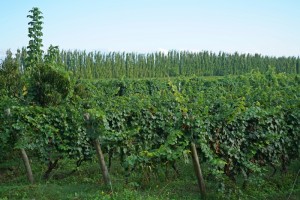 |
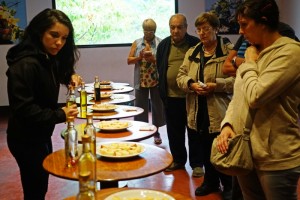 |
March 31 Friday: Mendoza – Full Day Excursion to Alto Montaňa
A Brazilian friend who travelled by road from Santiago to Mendoza, has said it’s a most scenic route. As I have come from Northern Argentina, I am interested in this legendary Route 7. I was told to wait for the bus at the hotel lobby at 7am. But the bus did not turn up till 8:30am as I was the last passenger. Frustrating and waste of time! We had 14 passengers and I was the only English-speaking passenger. Luckily the guide is bilingual. We travelled about 200km today and had a couple of photo stops. The first one was at the Potrerillos Lake which supplies water to Mendoza. Then we stopped at Uspallata for breakfast. The road follows Rió Mendoza with mountains on both sides.
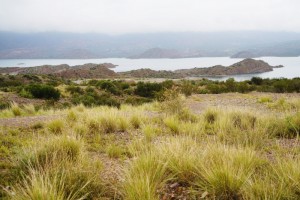 |
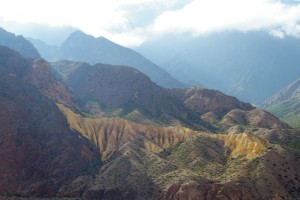 |
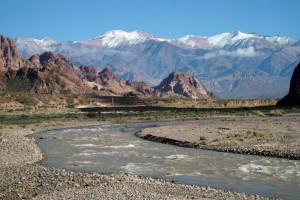 |
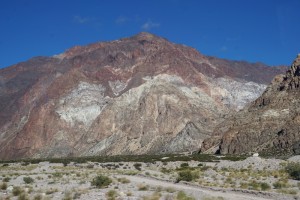 |
At Penitentes which is a ski resort, I took the chairlift to the first station for a panoramic view of the valley (ARS 80).
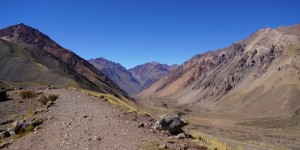 |
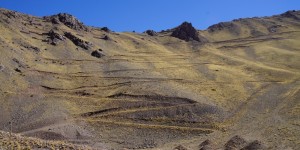 |
After a few minutes’ drive, we arrived at Puente del Inca (the Inca Bridge), a natural arch formed over the Vacas River. It is also the name of nearby hot springs. Charles Darwin who visited the site in March 1835 was impressed by the geology and land formation. In early 20th century, a large thermal resort was built and tourists arrived by train. This was one of the last Argentine stations of the Transandie Railway before the train continued into Chile. This is a natural wonder and the highlight of the day: the eerie colours of golden yellow, brown and green and formation are impressive. I have never seen features like this on such a large scale and the vivid colours before.
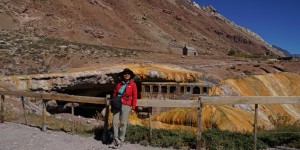 |
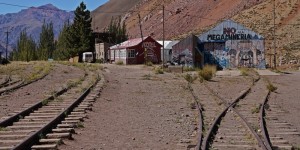 |
We had a snapshot of Aconcagua from Route 7 (Originally I planned to make a day hiking trip to the national park but that tour was full). The bus then climbed to the pass of La Cumbre, where the monument of Christ the Redeemer of the Andes was erected at 3832m above sea level at the border of Argentina and Chile. This location is the highest point on the old road between Mendoza and Santiago de Chile. The monument, a symbol of eternal peace, was unveiled on March 13, 1904 as a celebration of the peaceful resolution of the border dispute between the two countries.
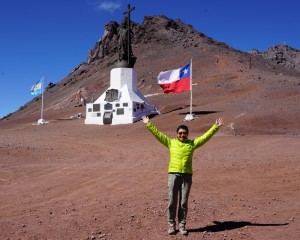 |
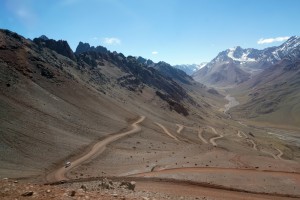 |
We had a lunch break around 3pm. I did not fancy a buffet lunch food and preferred having a proper dinner in the evening. I was back in my hotel around 8pm and went to a restaurant recommended by the receptionist. I had a set dinner with a juicy and tender steak and ¼ litre of house wine for less than ARS 230. Great value! I strolled around the city which looks safe with locals sitting in cafes and parks.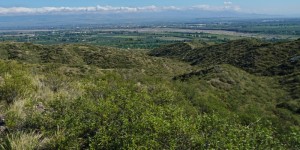
April 1 Saturday: Mendoza – Horse-riding and Wine-tasting; Overnight bus to Buenos Aires
I like horse-riding. On the recommendation of the tour operator, I paid ARS 1000 for a half-day excursion with horse-riding to a vineyard and asado lunch. This tour turned out to be the best tour I had during this trip. We had a small group of six. A couple and I were picked up by the leader in his car at 9pm. He took us to a stable in the Lujan de Cuyo Valley 25km from the city. This area is rural and quiet with unpaved roads and vineyards. Three riders were already waiting for us. I mounted on the horse with assistance and followed our guide on a well-trodden path. My horse is tame and self-guided (like me!).
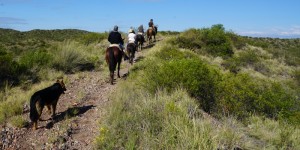 |
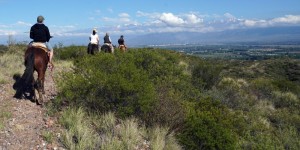 |
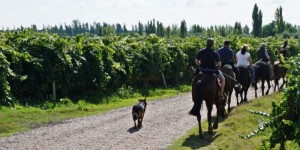 The view of the vineyards and the valley is good. We rode for an hour and a half before heading to the vineyard. We finally arrived at the winery by the Krontiras family which building and equipments look new and modern. I watched workers putting fresh grapes on a conveyance belt. When a 500-litre container is full of grapes and juice, two staff push it indoor and tip the container over to let the content falling into a gigantic cylinder below. The grapes and juice would be left alone for a period of time to let it ferment. Then the sediments would be removed and the wine would stay in another container till it is ready to go into barrels.
The view of the vineyards and the valley is good. We rode for an hour and a half before heading to the vineyard. We finally arrived at the winery by the Krontiras family which building and equipments look new and modern. I watched workers putting fresh grapes on a conveyance belt. When a 500-litre container is full of grapes and juice, two staff push it indoor and tip the container over to let the content falling into a gigantic cylinder below. The grapes and juice would be left alone for a period of time to let it ferment. Then the sediments would be removed and the wine would stay in another container till it is ready to go into barrels.
We visited the wine cellar where some 500 barrels are stored. The layout, lighting and design resemble a museum: everything is artistically and beautifully laid out. The walls of the common areas are covered with photos of beautiful photos of birds from the Antarctica. The guide said the Greek owner is a professional photographer and the winery is his passion. How wonderful!
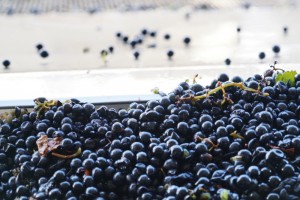 |
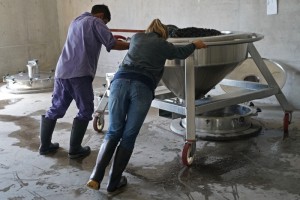 |
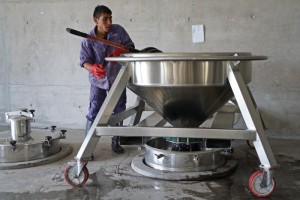 |
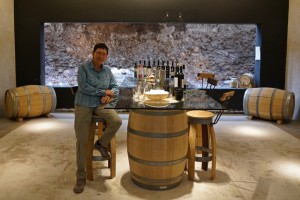 |
We tasted two bottles of Malbec. I brought a bottle of Doña Silvina Reserve Malbec 2010 and would open it on a special occasion. I rode back to the house where we had a lovely asado lunch. It’s a wholesome meal and I had two glasses of wine and finished all the meat on my plate. I was full and did not eat for the rest of the day!
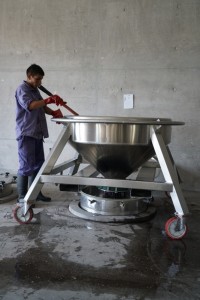 |
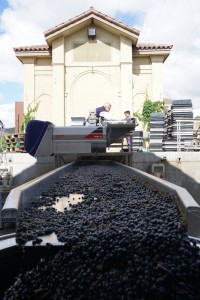 |
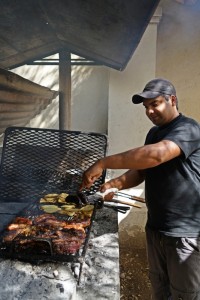 |
I was back in the hotel by 3pm and spent the next two hours exploring the city on foot. I went as far as the lake of the General San Martín Park.
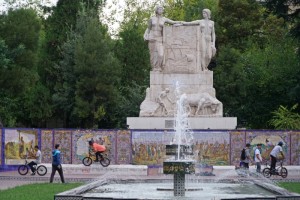 |
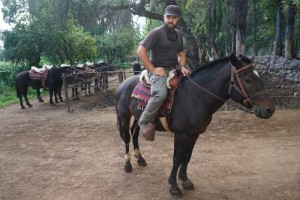 |
By 5pm, I was tired and ready to leave. I took a taxi to the bus terminal hoping to get on the 6:30pm bus to Buenos Aires. But the bus company told me as I had a discount and non-changeable ticket, I could not take an early bus without penalty. I was not in a hurry and waited for the 8:30pm bus which turned out to be new and comfortable.
April 2 Sunday: Buenos Aires
The bus was 20% full and I had two seats again. This time I was able to sleep fairly well and got up before 7am. I watched sunrise and had a continental breakfast in a road side cafe (provided by the bus company). I arrived in the capital around 11am in relatively good shape! I took a taxi to Hotel HTL 9 de Julio. According to the meter, the fare was ARS 301. Locals had told me the ride should be between ARS 100-150. I think I have been cheated as the meter has been compromised. The hotel has been recommended to me by a traveller I met in Tilcara. All rooms are duplex which sleep 3-4 persons. The duplex is nice, airy and comfortable. I had excellent views of Avenue 9 de Julio and the obelisk.
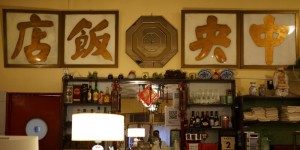 I was in the city with Lillian in 1989. But I could hardly remember where we had stayed and the places we had visited. The only memory of my first visit includes hyperinflation, asado and tango. It’s time to discover (or rediscover) the city by exploring it on foot as far as possible – this is the only way I can feel and remember a place.
I was in the city with Lillian in 1989. But I could hardly remember where we had stayed and the places we had visited. The only memory of my first visit includes hyperinflation, asado and tango. It’s time to discover (or rediscover) the city by exploring it on foot as far as possible – this is the only way I can feel and remember a place.
The first thing I did this time was to have lunch in the Chinese restaurant on Rivadavia where the film “Happy Together” by Hong Kong’s famous director Wong Kar Wai was filmed 19 years ago. I met the owner who has lived here for some 50 years. I paid ARS 260 for fried rice noodles and tea. Not cheap!
A few minutes’ walk took me to the Plaza de Mayo which is surrounded by important and historical buildings including the Metropolitan Cathedral, Casa Rosada (Government House) and the Cabildo. I watched a large group of protestors chanting slogans in the square on the anniversary of British invasion of Falkland Islands in 1982.
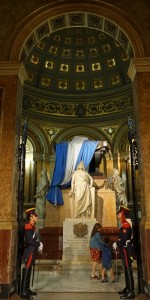 |
|
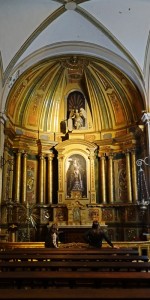 |
It started to rain. I had an umbrella and continued my exploration in the rain. I turned into Defensa to see the Sunday Market. Stalls selling souvenirs, art works, clothing and food line all the way to Plaza Dorrego, the heart of San Telmo, the oldest neigbhourhood in the city. This is a well-preserved area characterised by its colonial buildings. Cafes, tango parlors and antique shops line the cobblestone streets often filled with artists and dancers. Unfortunately, there were few people owing to the poor weather. But eateries, pubs and bars still had plenty of patrons. I visited the San Pedro Telmo, an old church and an antique fair before finding my way to the covered market with a few stalls selling vegetables, fruits, meat etc. The eateries seemed more popular with many young customers.
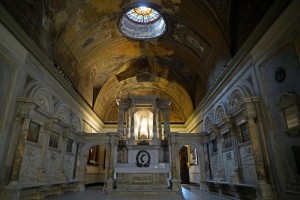 |
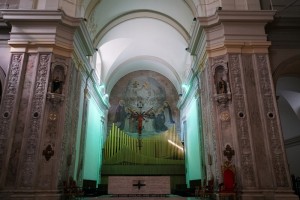 |
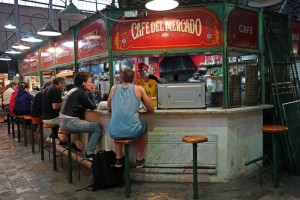 |
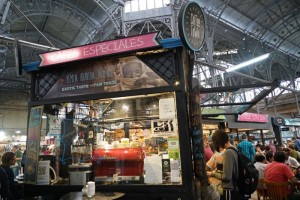 |
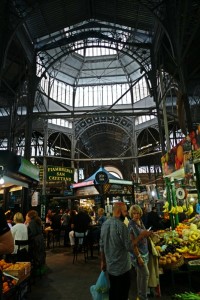 |
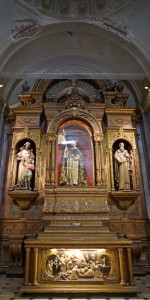 |
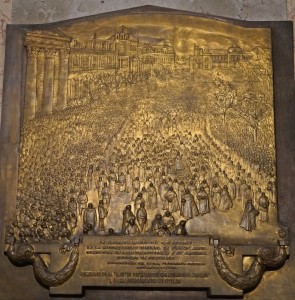 |
Few blocks from San Telmo is the Colonia Express pier. I brought a ferry ticket to Colonia del Sacramento, Uruguay on promotion for ARS614. It’s 5pm and I made my way back to Avenue 9 de Julio. I deliberately got myself lost so that I could discover different parts of this old neighbourhood. I must have walked at least six kilometres today. I was tired by the time I reached the hotel. Ready for bed!
April 3 Monday: Buenos Aires, Argentina – Colonia del Sacramento , Uruguay – Montevideo
My original plan was to take the 12:30 pm ferry to Colonia where I stayed a night before heading to Montevideo, the capital of Uruguay. I changed my mind while on the boat and decided to go to Montevideo first and spend the last night in Colonia before returning to Buenos Aires on April 6. I took a backpack and left the heavy suitcase in HTL 9 de Julio. I got up early and wandered through Defensa and Puerto Madero before arriving at the pier.
I was early and spent over an hour in the cafe enjoying a cup of coffee and writing my travel notes. The boat was late and I did not arrive in Colonia after 2pm. As I had only had a ticket to Colonia and not Montevideo, the ferry company did not allow me to board its bus to Montevideo though I was ready to pay for the bus ticket. As a result, I had to walk to the bus terminal nearby to take a bus. The 3pm bus was full and I had to wait for the 4 pm bus and did not arrive at the bus terminal in Montevideo after 7 pm. It‘s a pity to waste the whole day on the road.
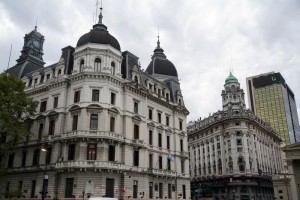 |
I changed money at the ferry terminal (€1 to Uruguayan peso (UYU) 29) and bought a bus ticket for UYU 364 (I am sure I would have paid less had I booked a ferry+bus ticket with Colonia Express). I had no hotel reservation. The young lady sitting next to me on the bus warned me about downtown which may not be safe. I went to the tourist information office in the bus terminal for assistance. The young man at the desk also advised me not to go to the downtown and suggested a hostel which owner could come to pick me up. He also arranged a tour to Punta del Este the next day for $40.
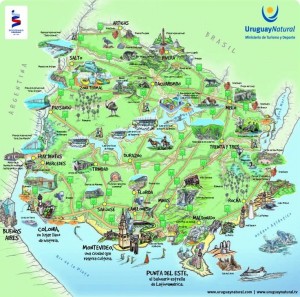 His friend soon turned up and drove me to Tibet Hostel on Ramon Masini, a few blocks from the beach of Potcio. The hostel also runs two eateries where lodgers enjoy a 10% discount. The place looks cozy. I paid $40 for two nights. I later found the toilet and shower far from satisfactory. But the worst things were the bugs/mosquitoes and the automatic lighting which kept turning on and off at the slight movements in the room. I was beaten and had a sleepless night!
His friend soon turned up and drove me to Tibet Hostel on Ramon Masini, a few blocks from the beach of Potcio. The hostel also runs two eateries where lodgers enjoy a 10% discount. The place looks cozy. I paid $40 for two nights. I later found the toilet and shower far from satisfactory. But the worst things were the bugs/mosquitoes and the automatic lighting which kept turning on and off at the slight movements in the room. I was beaten and had a sleepless night!
Uruguay is the second smallest nation in South America with an area of 176,000km² and a population of 3.5 million (est). It borders Argentina to its west and Brazil to its north and east, with the Rió de la Plata to the south and the Atlantic Ocean to the southeast. It was inhabited by the Charrúa people for approximately 4000 years before the arrival of Portuguese who founded Colonia del Sarcamento (Colonia) in 1680. The Spanish who was claiming sovereignty in the region, established Montevideo as a military stronghold in the early 18th century. In 1811, José Gervasio Artigas, Uruguay’s national hero, launched a successful revolution against the Spanish authorities. It finally won its independence in 1828 following a four-way struggle between Spain, Portugal, Argentina and Brazil. But it remained subject to foreign influence throughout the 19th century with the military playing a recurring role in domestic politics. In 1984, the country returned to democracy when national elections were held.
The country has made remarkable progress politically, economically and socially since the 1980s. By 2016, the GDP(PPP) and (PPP) per capita reached $74 billion and US$21,570respectively. Itis now ranked first in Latin America in democracy, peace, lack of corruption and e-government and is first in South America in terms of press freedom, size of the middle class and prosperity. It is regarded as a high-income country and one of the most socially developed countries. In addition, 95% of its electricity comes from renewable energy, mostly hydroelectric facilities and wind parks.


